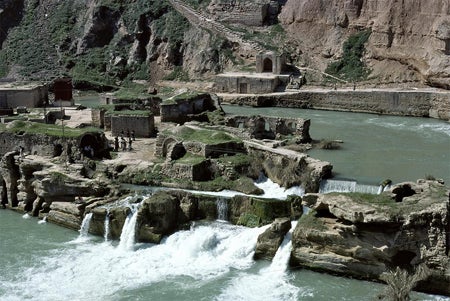Announcing the winners of the ARTstor Travel Award 2013!

Ordered by Shapur I | Dam and Bridge at Shushtar; c. 260 | Shushtar, Iran | Islamic Art and Architecture Collection (Sheila Blair, Jonathan Bloom, Walter Denny)
Congratulations to the five winners of this year’s ARTstor Travel Awards! They will each receive $1,500 to be used for their teaching and research travel needs over the course of the next year. The winning essays and accompanying images will be posted in the blog in the near future.
Our thanks to everyone who submitted an essay. Our committee was very impressed by the creative ways that our users integrate the images in the ARTstor Digital Library into their teaching and research. We hope to feature notable submissions from runners up in the blog throughout the year.
The ARTstor Travel Awards 2013 winning essays are:
Peyvand Firouzeh, PhD Candidate, University of Cambridge
Shushtar: A Town to Tame Water
The aridity of the Middle East stands in contrast to the landscape architecture of Islamic gardens, where water is used generously and luxuriously. The contrast hints at creative methods of dealing with water scarcity: from man-made canals and reservoirs to cisterns and qanats (subterranean tunnel-wells). Firouzeh focuses on Shushtar, a town in southwest Iran, by looking at the ways its inhabitants applied to tame water, making the nearby river not only a resource for the essentials, but also an amenity for leisure.
Lisa Hartley, Student Services Associate, Columbus College of Art Design
Wrapped Up in Lace: Chantilly
Coco Chanel called lace “one of the prettiest imitations ever made of the fantasy of nature,” and Hartley introduces us to Chantilly, the tiny town in France where the craft originated. The traditions and skills used there date back as early as the 16th century, when European nobility commissioned workers to create dresses, parasols, shawls, and gloves in beautiful openwork fabric.
Anne C. Leader, Art History Professor, Savannah College of Art and Design-Atlanta
Florence: City of the Living, City of the Dead
While the primary motivation for patrons of religious architecture and decoration was to gain or retain God’s grace, Florentine tomb monuments manifest a conflicting mix of piety and social calculation, reflecting tension between Christian humility and social recognition. Leader’s essay reconstructs the rich mosaic of tomb markers that once covered the floors, walls, and yards of the Florentine cityscape to bring us closer to how Florentines experienced the deaths and memories of their kin, friends, and competitors in the early modern city.
Marlene Nakagawa, Undergraduate student at the University of Oregon
Alexandria: The City
From Pakistan to Turkey, Alexander the Great founded or renamed nearly twenty cities after himself as a representation of his omnipresence in the ancient world. Over the centuries, most of these Alexandrian cities have been destroyed, renamed, or absorbed into other territories. Nakagawa introduces to the major exception: Alexandria, Egypt’s largest seaport, which continues to be a dynamic force in the country’s ancient and modern economy.
Amber N. Wiley, Ph.D., Visiting Assistant Professor of Architecture, Tulane University
Washington’s Secret City: Cultural Capital
African Americans made up from a quarter to a third of Washington, D.C.’s population throughout the nineteenth century, and historian Constance Green characterized the capital in the early 1900s as the “undisputed center of American Negro civilization.” This population peaked between 1960 and 1990. Wiley’s submission tells the story of African Americans in Washington and their significant contribution to the nation’s capital since its founding in 1790.